|
This .925 sil ver 10,000 forint is in proof quality. It weighs 31.46 grams and is 38.61 mm (1½ inches) in diameter. Issue limit is 5,000 coins. ver 10,000 forint is in proof quality. It weighs 31.46 grams and is 38.61 mm (1½ inches) in diameter. Issue limit is 5,000 coins.
Ignác Semmelweis ranks among the world’s best known Hungarians. In 1906, a street was named after him in Budapest. His name was adopted by the Budapest medical university in 1969, and in 1991 by the Vienna gynecological clinic where he once worked. His memory is also preserved in the name of a minor planet, 4170 Semmelweis. His birthplace was made into a museum in 1965, and operates today as the Semmelweis Medical History Museum, Library and Archive. In 2013, UNESCO added the discovery made by “the savior of mothers” that childbed, or puerperal fever (also known as postpartum infections) could be eliminated by proper hygiene, to its “Memory of the World” register.
To mark the 200th anniversary of Semmelweis' birth on July 1, 1818, the National Bank of Hungary is issuing a 10,000 forint silver and a 2,000-forint copper-nickel commemorative coin. The front of the coin features a 3/4-view portrait of Semmelweis, with his initials next to it. The bottom legend “1818-1865” refers to the dates of his birth and death.
The central motif on the reverse is a hospital scene in which Semmelweis is shown washing his hands with a mother and child in the background. Particular emphasis is placed on the bottle containing chlorinated lime and the depiction of hand-washing. The coin was designed by numismatic artist Gábor Kereszthury.
Ignác Fülöp Semmelweis was born on 1 July 1818, the fifth child of wealthy merchant József Semmelweis and Terézia Müller. After completing secondary school at the Royal University Catholic Gymnasium of Buda, he started law school in Vienna in 1837, but switched to medical school that same year, against the wishes of his father, who wanted him to become a military judge.
Semmelweis is known as the “savior of mothers.” Based on statistics and his own research and observations, he was the first person to discover that “childbed fever” was not a disease, but rather an infection spread by doctors. He demonstrated that the cause and effect chain of the infection causing childbed fever, which had an extremely high mortality rate, could be prevented by doctors and midwives carefully washing their hands. By introducing the practice of washing hands with a chlorinated lime solution, he was able to reduce the mortality rate from 25-30% to 1%.
The preventive measures he proposed were revolutionary and 30 years ahead of their time, and thus they were rejected by the medical science of the era. His discovery and theories were only recognized and applied starting in 1877, based on the work of Louis Pasteur and Robert Koch (bacteriology), and Joseph Lister (antiseptic surgery). Semmelweis was the first to establish the practice of aseptic gynecology and child delivery, which was the forerunner to the principle of antiseptic surgery.
|















